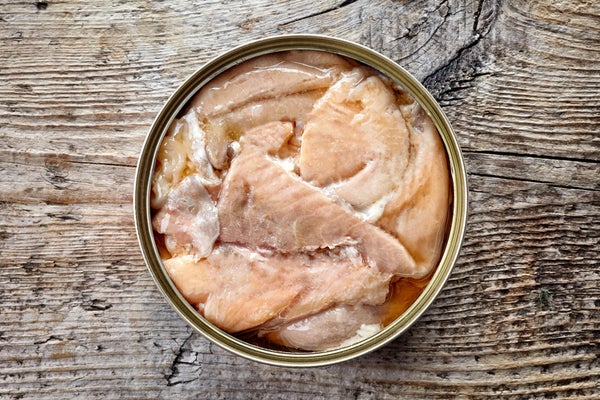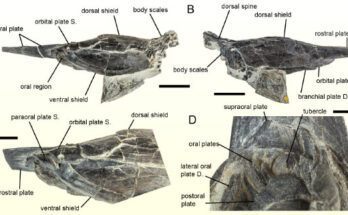A long time-old Cans of Salmon Reveal Modifications in Ocean Well being
Researchers used tinned fish to reconstruct parasitic inhabitants change, giving new that means to the phrase “opening a can of worms”

Reinis Bigacs/Alamy Inventory Picture
Chelsea Wooden, a parasite ecologist on the College of Washington, and her then graduate pupil Natalie Mastick had been pondering for months how they may reconstruct fluctuations over time within the danger parasites pose to marine mammals within the Pacific Northwest. No long-term datasets exist for the overwhelming majority of parasitic species, so Wooden and Mastick knew they’d must get inventive. One thought that they had was to make use of salmon’s parasitic hundreds as proxies for marine mammal an infection.
Killer whales, seals and belugas prey on salmon, that are an intermediate host for varied nematodes that full their several-step life cycle in these predators. The parasites can not breed and enter the surroundings with out marine mammals, so the extent of an infection in salmon is intimately tied to that of their predators.
Whereas the logic behind the researchers’ thought of utilizing salmon parasites to know marine mammal parasites was sound, there was nonetheless one drawback: The place would they get a bunch of outdated salmon that they may dissect to search for parasites?
On supporting science journalism
When you’re having fun with this text, take into account supporting our award-winning journalism by subscribing. By buying a subscription you’re serving to to make sure the way forward for impactful tales concerning the discoveries and concepts shaping our world in the present day.
They appeared to be out of choices when, “out of the blue,” Wooden says, she obtained a name from the Seafood Merchandise Affiliation, a commerce group in Seattle. The group informed her it was cleansing out its basement and was eliminating stacks of dusty containers of long-expired canned salmon. Earlier than throwing the cans away, the affiliation puzzled if Wooden would possibly need them.
“We had been like, ‘Worms could possibly be in there!’” Wooden recollects. “That’s how we began on this examine: [the Seafood Products Association] asking us if we wished this trash from their basement and us saying, ‘Completely, sure.’”
Wooden and Mastick’s hunch about canned salmon probably serving as a time capsule for worms turned out to be right: the tinned fish contained tons of parasites. Because the researchers reported this week in Ecology and Evolution, they had been ready to make use of the recovered parasites to reconstruct how an infection burden has modified over the course of 42 years in 4 salmon species and located that it elevated in two. Whereas this would possibly sound like a foul factor, the researchers suspect that the uptick in worms alerts “a conservation success story” for marine mammals, Wooden says. “It’s potential as marine mammals have come again, their parasites have come again, too.”
Canned salmon will get cooked because it’s sealed, so going into the examine, the researchers had been not sure whether or not they would be capable to detect any anisakids, the kind of parasitic nematodes that infect the muscle of Alaskan salmon. The worms, nonetheless, “had been very noticeable—not less than for us,” Wooden says. “We had been actually stunned.”
Anisakids discover their means into salmon by smaller intermediate hosts reminiscent of krill or fish. After the salmon eat these smaller hosts, the parasites burrow into the salmon’s muscle, making “a bit pocket,” Wooden says. She and her colleagues rigorously picked by the salmon muscle tissue with forceps, and after they opened one of many pockets, the worms tended to “spring out,” Wooden says. “They had been very simply seen.” (These worms happen in lots of varieties of seafood, she provides, and since they’re killed within the cooking course of, they pose no hazard to people except meals is undercooked or an individual has a specific allergy to them.)
The basement stash that enabled the findings consisted of 502 cans of chum, coho, pink and sockeye salmon, largely from Alaska. The researchers dissected 178 cans in complete, processed between 1979 and 2019 and ranging from 22 to 62 cans per species. Half the cans contained nematodes, they usually collected a complete of 372 worms. They discovered that the variety of worms per gram of tissue considerably elevated over time in chum and pink salmon however that it didn’t change in sockeye or coho salmon.
“It’s necessary we perceive how parasites and illness typically are influencing ecosystems as a result of results could be profound,” says Ryan Carnegie, a biologist on the Virginia Institute of Marine Science, who was not concerned within the analysis. “The notion to make use of this archive of canned samples to deal with the query of long-term nematode an infection in salmon was merely impressed, and importantly, it was adopted by strong and really cautious approaches to generate strong quantitative information to check the speculation of change.”
The authors of the brand new examine can not say for positive what components are driving the rise in parasite numbers in chum and pink salmon. However the uptick does coincide with the creation of the Marine Mammal Safety Act, which went into impact in 1972. Populations of assorted marine mammals have elevated since then, so it tracks, Wooden says, that their parasites would have elevated, too. Different research have revealed comparable correlations tied to conservation actions, together with a rise of parasites in Baltic cod as grey seal populations recovered. As Wooden notes, “We all know this as a result of fishermen had been pissed as a result of they saved touchdown all this cod ridden with worms.”
Wooden and her colleagues additionally have no idea why sockeye or coho salmon didn’t expertise a rise in parasite hundreds. They’re hoping to seek out some ecological hints at this reply by a genetic evaluation they’re presently engaged on to attempt to establish the particular parasitic species recovered from the tinned salmon.
Already, the brand new analysis offers “a view into a number of the most hard-to-study species and provides perception into the nuanced means that ecosystems get well,” says Loren McClenachan, an ocean historian on the College of Victoria in British Columbia, who was not concerned within the analysis.
“Utilizing canned salmon as a window into previous ecosystems is a remarkably inventive method to disclose in any other case invisible change,” she says. “The discovering that parasites have elevated in some salmon species as their marine mammal hosts have elevated is notable and exhibits that baselines for wholesome ocean ecosystems could also be wormier than individuals would possibly assume.”



